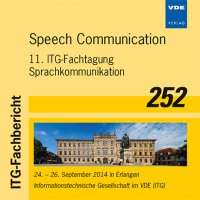Linear Predictive Coding With Backward Adaptation and Noise Shaping
Conference: Speech Communication - 11. ITG-Fachtagung Sprachkommunikation
09/24/2014 - 09/26/2014 at Erlangen, Deutschland
Proceedings: Speech Communication
Pages: 4Language: englishTyp: PDF
Personal VDE Members are entitled to a 10% discount on this title
Authors:
Korse, Srikanth; Krueger, Hauke; Pawig, Matthias; Vary, Peter (Institute of Communication Systems and Data Processing, 52074 Aachen, Germany)
Abstract:
In linear predictive coding, the benefit of backward adaptation in comparison to forward adaptation of the prediction coefficients is that it allows to save bit rate since no prediction coefficients need to be transmitted from the encoder to the decoder. Also, backward adaptation yields very low complexity and algorithmic delay. Unfortunately, noise shaping techniques which have proven to enable higher perceptual quality in speech and audio coding than approaches without noise shaping have been proposed only for forward adaptation. In order to overcome this shortcoming, in this paper we propose a novel scheme for noise shaping in linear predictive coding with backward sequential adaptation. The new concept is investigated involving two different methods for the adaptation of the prediction coefficients, the Gradient Adaptive Lattice (GAL) and the Normalized Least Mean Square (NLMS) algorithm. Measurements of the perceptual speech quality for a database of speech examples based on the well-known Perceptual Evaluation of Speech Quality (PESQ) measure show that due to the involved noise shaping a significant increase of the perceived quality can be achieved for speech signals sampled at 8 kHz sampling frequency with bit rates of 40, 32 and 24 kbits/s.


